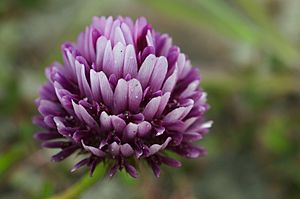Trifolium wormskioldii facts for kids
Quick facts for kids Trifolium wormskioldii |
|
|---|---|
 |
|
| Conservation status | |
| Scientific classification | |
| Genus: |
Trifolium
|
| Species: |
wormskioldii
|
| Synonyms | |
|
Lupinaster wormskioldii |
|
Trifolium wormskioldii is a type of clover plant. It has many common names, like cows clover, coast clover, and springbank clover. This plant is special because it's native to a large part of western North America.
Contents
Where Does This Clover Grow?
This clover grows naturally in the western half of North America. You can find it from Alaska all the way down through California to Mexico. It's a tough plant that can live in many different places.
What Kind of Places Does it Like?
Trifolium wormskioldii can grow in many different environments. It lives from sandy beaches to high mountain ridges. You can find it in places like chaparral (shrublands) and oak woodlands. It also thrives in grasslands and different types of forests. These include yellow pine forests, red fir forests, and lodgepole forests. It even grows in wetlands and along rivers, which are called riparian areas.
What Does This Clover Look Like?
Trifolium wormskioldii is a legume, which means it's part of the pea family. It's a perennial herb, so it lives for more than two years. Sometimes it grows like a mat on the ground. Other times, its stems stand upright.
Leaves and Flowers
The leaves of this clover are made up of smaller leaflets. Each leaflet is about 1 to 3 centimeters long. The lower parts of the leaf stems have small, stiff hairs called bristles. The upper parts might have tiny teeth.
The flowers grow in round clusters. These clusters are usually 2 or 3 centimeters wide. The sepals, which are like small leaves protecting the flower, also have bristly tips. The flowers themselves are often pinkish-purple or magenta. They usually have white tips, making them quite pretty.
How People Use This Clover
Many Native American groups in western North America have used this clover as a food source for a long time.
Clover as Food
Both the leaves and the flowers of Trifolium wormskioldii can be eaten raw. Sometimes, people would add a little salt to them. The roots were also a common food. They were often steamed or boiled. People would eat the cooked roots with fish, fish eggs, and fish grease.
Home for Butterflies
This clover plant is also important for insects. It is a host plant for the caterpillars of the Western cloudywing butterfly (Thorybes diversus). This means the caterpillars eat the clover leaves as they grow.
How This Clover Got Its Name
The scientific name, Trifolium wormskioldii, was given to honor a Danish botanist. His name was Morten Wormskjold.


